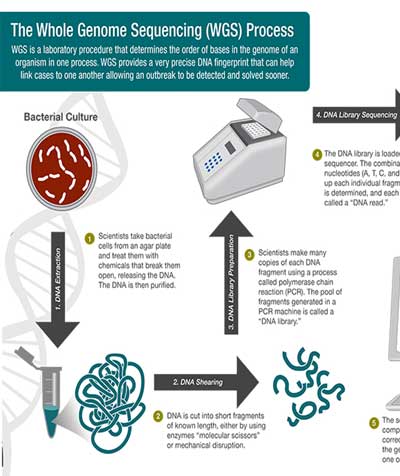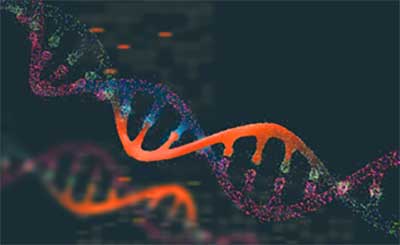GS-3: Science and Technology- developments and their applications and effects in everyday life.
Key words: Genome, Genome Sequencing, DNA, CSIR, India genome project, INSACOG
Why in News:
With the aim of taking genome sequencing to hard-to-reach locations and reducing the time to get results from these tests, CSIR-India’s Institute of Genomics and Integrated Biology has partnered with FIND, a global alliance for diagnostics.
What is Genome and Genome Sequencing?
- A genome is the DNA, or sequence of genes, in a cell.
- Genome Sequencing means determining the order of the four chemical building blocks - called "bases" - that make up the DNA molecule. The sequence tells scientists the kind of genetic information that is carried in a particular DNA segment.
- Every human cell contains a pair of chromosomes, each of which has three billion base pairs or one of four molecules – adenine (A), thymine (T), guanine (G), and cytosine (C) – that pair in precise ways.
- For example, In this particular piece of DNA, an adenine (A) is followed by a guanine (G), which is followed by a thymine (T), which in turn is followed by a cytosine (C), another cytosine (C), and so on.

How does genome sequencing work?
Scientists conduct genome sequencing by following these four main steps:
- DNA shearing: Scientists begin by using molecular scissors to cut the DNA, which is composed of millions of bases: A’s, C’s, T’s and G’s, into pieces that are small enough for the sequencing machine to read.
- DNA bar-coding: Scientists add small pieces of DNA tags, or bar codes, to identify which piece of sheared DNA belongs to which bacteria. This is similar to how a bar code identifies a product at a grocery store.
- Whole genome sequencing: The bar-coded DNA from multiple bacteria are combined and put in the whole genome sequencer. The sequencer identifies the A’s, C’s, T’s, and G’s, or bases, that make up each bacterial sequence. The sequencer uses the bar code to keep track of which bases belong to which bacteria.
- Data analysis: Scientists use computer analysis tools to compare bacterial sequences and identify differences. The number of differences can tell the scientists how closely related the bacteria are, and how likely it is that they are part of the same outbreak.

Why is genome sequencing so important?
- The primary purpose of sequencing one’s genome is to obtain information of medical value for future care. Genomic sequencing can provide information on genetic variants that can lead to disease or can increase the risk of disease development, even in asymptomatic people. Thus genome sequencing has the potential to increase the ability to act pre-emptively prior to disease development or commence treatment for a disease that has not yet been diagnosed. For people experiencing a health-impacting condition, DNA sequencing can provide a precise diagnosis which might affect the medical management of symptoms, or provide treatment options.
- To identification of various variants of a particular diseases. Ex. Variants of covid 19 i.e. delta variants and omicron etc.
- It can help in increasing immunity against diseases that has no treatment yet like HIV, COVID etc by improving human response against them through correct identification and editing of responsible gene.
- Another advantage of genome sequencing is that information regarding drug efficacy or adverse effects of drug use can be obtained.
Applications of Genome Sequencing:
- Forensics: Genome Sequencing has been applied in forensics science to identify particular individual because every individual has unique sequence of his/her DNA It is particularly used to identify the criminals by finding some proof from the crime scene in the form of hair, nail, skin or blood samples. It is also used to determine the paternity of the child Similarly, it also identifies the endangered and protected species
- Medicine: In medical research, Genome Sequencing can be used to detect the genes which are associated with some heredity or acquired diseases, Scientists use different Techniques of genetic engineering like gene therapy to identity the defected genes and replace them with the healthy ones.
- It can help us understand diseases including genotyping of specific viruses to direct appropriate treatment, in the identification of mutations linked to different forms of cancer,
- Agriculture: Genome Sequencing has played vital role in the field of agriculture. The mapping and sequencing of the whole genome of microorganisms has allowed the agriculturists to make them useful for the crops and food plants For example, specific genes of bacteria have been used in some food plants to increase their resistance against insects and pests and as a result the productivity and nutritional value of the plants also increases These plants can also fulfil the need of food in poor countries Similarly, it has been useful in the production of livestock with improved quality of meat and milk.
Genome India Project
- Department of Biotechnology (DBT) initiated the ambitious “Genome India Project” (GIP) on 3rd January 2020.
- This project is led by the Centre for Brain Research at Bengaluru-based Indian Institute of Science, which acts as the central coordinator between a collaboration of 20 leading institutions, each collecting samples and conducting its own research.
- The GIP aims to collect 10,000 genetic samples from citizens across India, to build a reference genome
- This would aid our understanding of the nature of diseases affecting the Indian population, and then ultimately support the development of predictive diagnostic markers.
- Some of the priority areas are Precision health, Rare genetic disorders, Mutation spectrum of genetic and complex diseases in the Indian population, Genetic Epidemiology of Multifactorial Lifestyle Diseases, and Translational Research.
Indian SARS-CoV-2 Genomics Consortium (INSACOG)
- It is jointly initiated by the Union Ministry of Health, and Department of Biotechnology (DBT) with CSIR and ICMR, is a consortium of 28 National Laboratories to monitor the genomic variations in the SARS-CoV-2.
- Established in December 2020.
- INSACOG is a multi-laboratory, multi-agency, Pan-India network to monitor genomic variations in the SARS-CoV-2 by a sentinel sequencing effort.
- Knowledge generated through this research consortium will assist in developing diagnostics & potential therapeutics & vaccines in the future.
Way forward:
- The genome sequencing has the potential to transform healthcare using precision medicine, addressing genetic disorders and improving agriculture by identifying genes and genetic variations in our country. So there is a need to utilise it in effective manner for the benefit of human beings.
Source: The Hindu BL
Q. What is genome sequencing? Is it really useful in the current scenario of diseases outbreak in world? Examine.























